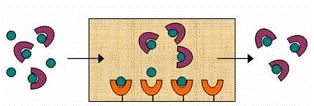Department of Chemistry
Document Type
Article
Date of this Version
10-2012
Citation
Published in final edited form as: J Pharm Biomed Anal.2012 October ; 69: 93–105. doi:10.1016/j.jpba.2012.01.004. Version presented here is from NIH PubMed Central.
Abstract
Affinity chromatography is a separation technique that has become increasingly important in work with biological samples and pharmaceutical agents. This method is based on the use of a biologically-related agent as a stationary phase to selectively retain analytes or to study biological interactions. This review discusses the basic principles behind affinity chromatography and examines recent developments that have occurred in the use of this method for biomedical and pharmaceutical analysis. Techniques based on traditional affinity supports are discussed, but an emphasis is placed on methods in which affinity columns are used as part of HPLC systems or in combination with other analytical methods. General formats for affinity chromatography that are considered include step elution schemes, weak affinity chromatography, affinity extraction and affinity depletion. Specific separation techniques that are examined include lectin affinity chromatography, boronate affinity chromatography, immunoaffinity chromatography, and immobilized metal ion affinity chromatography. Approaches for the study of biological interactions by affinity chromatography are also presented, such as the measurement of equilibrium constants, rate constants, or competition and displacement effects. In addition, related developments in the use of immobilized enzyme reactors, molecularly imprinted polymers, dye ligands and aptamers are briefly considered.



Comments
Copyright Elsevier Inc. Used by permission.